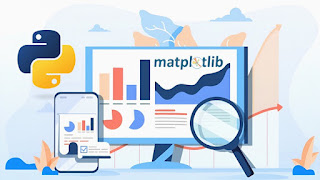[100% OFF] Advanced data visualization techniques with python
In today's data-driven world, the ability to convey complex information effectively is crucial. Raw data can often be overwhelming, making it challenging to uncover valuable insights. This is where data visualization comes to the forefront, transforming data into an accessible, organized, and visually compelling format. In this course, we go beyond the basics and delve into advanced data visualization techniques using Python, even exploring the fascinating realm of 3D visualization.
Why Should You Master Advanced Data Visualization in Python?
Data visualization isn't just a skill; it's a superpower that can be wielded in various contexts, from presenting information to managers, enhancing scientific papers, and adding depth to work projects, to simplifying university lectures, embellishing personal websites, and even creating captivating advertisements.
Let's explore the manifold reasons why data visualization is an indispensable tool in the realm of data science:
1. Discovering Data Trends:
Data visualization acts as a magnifying glass, enabling you to spot trends and patterns hidden within your data, insights that might elude you in raw data form.
2. Interactive Exploration:
Interactive visualizations engage your audience, allowing them to interact with the data, query specific points, and gain a deeper understanding of the information presented.
3. Gaining Perspective:
Data visualization provides a unique perspective on data. It shifts your focus from numbers and spreadsheets to a visual narrative that's more intuitive and easier to comprehend.
4. Explaining Data Processes:
Complex data processes become comprehensible through visualization. It simplifies the explanation of intricate data transformations and analyses.
5. Igniting Imagination:
Creative visualizations spark the imagination. They encourage viewers to explore data from different angles, fostering innovative insights.
6. Telling a Data Story:
Data visualization is storytelling with data. It helps you convey a narrative, making data more relatable and memorable.
7. Providing Context:
Data visualization contextualizes information, helping viewers understand how data fits into the bigger picture.
8. Educating Users:
Visualizations are educational tools. They facilitate learning by presenting complex concepts in an accessible manner.
9. Saving Time:
Instead of sifting through rows of data, visualizations offer a quick and efficient way to grasp key insights, saving precious time.
10. Aesthetically Pleasing:
- Beyond functionality, data visualization is an art form. It transforms data into visually stunning representations that captivate and engage.
These compelling reasons underscore the significance of data visualization in data science. It's not just about making data more accessible; it's about making data come alive. With the power to reveal trends, engage audiences, and enhance understanding, data visualization is an indispensable tool for anyone navigating the vast landscape of data.




Comments
Post a Comment
If you have any doubt, Please comment below!